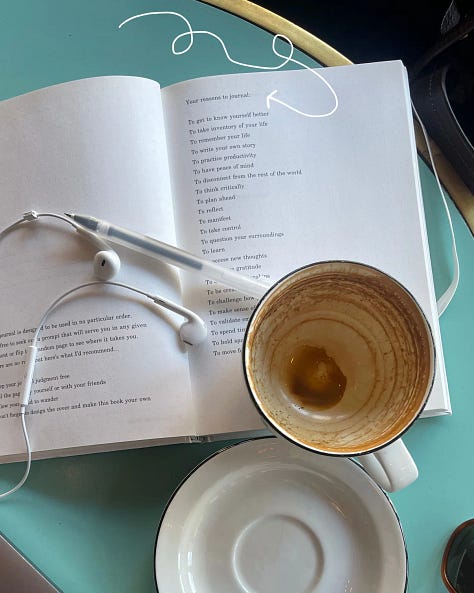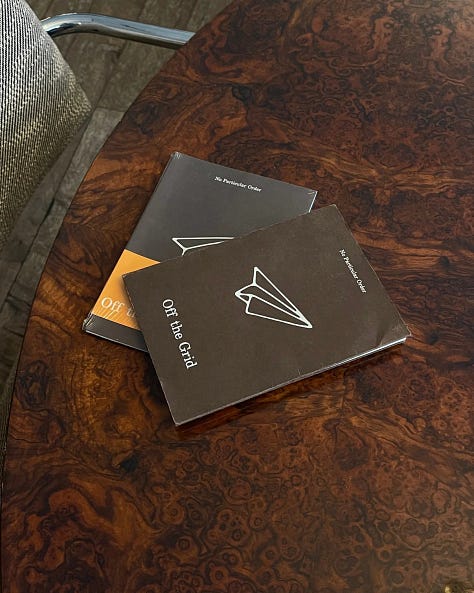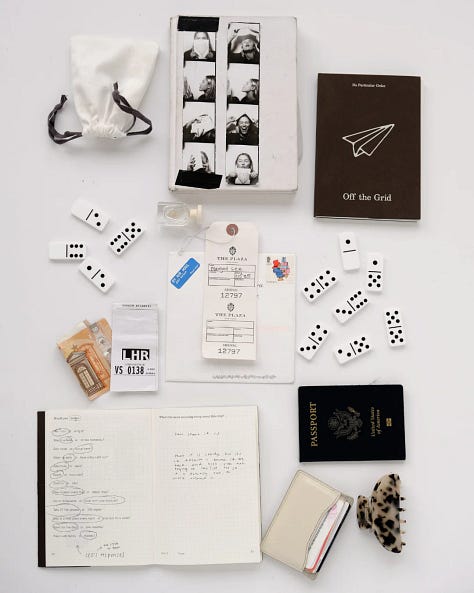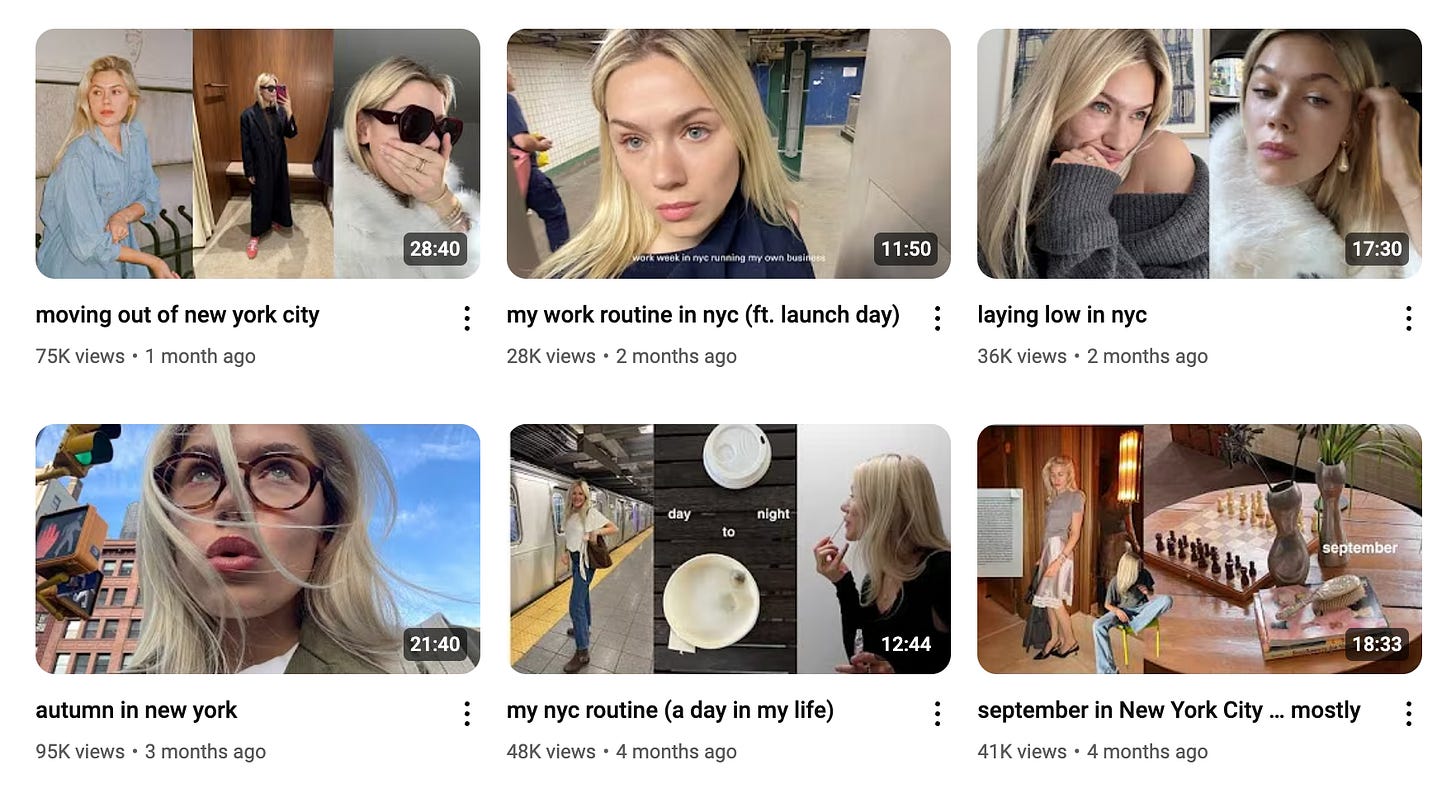Margot Lee on building an authentic brand
A conversation with the founder of No Particular Order 🖊️
Hello and welcome back to Brandscape!
This week, I’m thrilled to share my first audio edition and interview with
!Margot Lee is a content creator across platforms like YouTube and Instagram and the founder of No Particular Order. It was great to chat with her about the creator landscape and her journey of starting NoPo. Listen to our conversation at the top of this letter or check out the transcript below!
This interview transcript has been edited for clarity and conciseness. While every effort has been made to accurately represent the conversation, minor edits may have been made for readability.
HG: Hi everyone! Welcome to Brandscape’s first audio edition. I’m Henry Galicich, and today, I’ll be talking with content creator and entrepreneur Margot Lee. Margot, welcome to Brandscape!
ML: Thank you! I’m so excited to be here.
HG: You’ve been creating content for more than a decade. So many different people know you from various parts of your creator journey, whether through your YouTube channel or podcast, Working Title. But if someone’s meeting you for the first time, how would you introduce yourself and the work you do?
ML: I am a content creator across YouTube, Instagram, and other platforms where I talk a lot about lifestyle, fashion, and travel. I own a journaling brand called No Particular Order, where we primarily make prompted journals for pivotal moments in people’s lives.
HG: You’ve been creating content since the early days of YouTube. You talked about your lifestyle vlogs, and you’ve really taken your audience along every step of the way. In college, you were even featured in an NPR article about college students becoming influencers. It was interesting to re-read that article because they wrote about it in such a novel way, like, “Here are these college students that want to create content.” But now, it’s sort of a given that it’s a very lucrative career that people want to pursue. So, I’m wondering what it was like navigating the earlier years of your career and how your content has changed over time?
ML: This morning, I was thinking about a lesson I had in one of my classes about virality. I thought it was almost dated the way we were talking about it because a lot of the things we were referencing were the early days of YouTube, where there were viral videos. I don’t remember exactly what the point of the lesson was, other than the fact that virality is a very important, impactful thing for social media. At that time—probably around 2019 or 2020—there wasn’t really a platform that was affording people to go viral all the time, so it didn’t seem like a relevant conversation. Fast forward to now, that is the currency of being a creator. That has changed a lot of the landscape of how people create content, interact with others, and the things that they’re saying to get certain clicks.
Because I started before all of that was happening—thank god, because I don’t think I would do very well in this era of virality and having to depend on it to grow an audience—I was able to build a brand based on consistency. That was always my advice when people asked me how to grow an audience: it was consistency and quality. The crazy thing is I don’t think that holds up now. Consistency, maybe, but today that means posting 8-20 TikTok videos a day, which, to me, is absolutely unbelievable. I don’t know how people keep up with that and also create enough content and intrigue in their audience to be able to come up with new content all the time. A lot of it is about shock factor and wow factor.
Because I started early and grew with this audience who has known me, it has afforded me the opportunity to talk about my lifestyle in a very neutral way. Now, I think you need to really grab people’s attention, bring them in, and give them a reason to stay and continue to feel like there’s going to be these viral moments that they want to stick around for. So, the landscape is completely different. I think if I started today, I don’t think I would be able to have a career in social media because of the type of content I like to create. But it is very fascinating to see how it has changed. Going back to what you were saying about when I was a student, just to see really what the professors were picking up on that was going to be big. Another thing we talked a lot about was curation and how the job of content creators is curation and picking things out. That didn’t really exist when I was a student, so we were all trying to imagine what it was going to look like. Now, we’re seeing gift guides everywhere, outfits of the day, what’s in my bag, favorite products, and those are all examples of curation by content creators to provide value for their audience. It’s interesting to see what we were learning about in school and having conversations about has actually come to fruition now and how the landscape looks like how I couldn’t have even imagined it five years ago.
HG: Yeah, and it’s very clear that you’re an expert at curation with your gift guides and campaigns with brands like J. Crew. Where do you find your creative inspiration mostly, and how do you think about translating different creative ideas across all the media you show up on?
ML: I think inspiration can be tough on social media because it feels so repetitive. Even on Substack now, I go on the app, and I’m just seeing the same type of content over and over again. It feels very lackluster and uninspired, kind of. It’s the same types of Notes and posts in long-form that we’re seeing. I think that will change when people get more comfortable with the platform. Maybe it’s on me because I’m following the same types of people and need to diversify the people I consume content from across all platforms.
But, I had an “aha” moment recently. The time I was most successful on social media and really enjoying it the most was when I was in high school and college, and I wasn’t consuming a lot of content. I was looking at what my friends were posting on Instagram, watching a handful of YouTubers who had very different lives and were creating very different types of content. It was never something where I was looking to social media to get inspired and to create content that was similar to content they were creating. It was more of just an escape and something I enjoyed looking at and doing.
More recently, I’ve found myself looking to other creators: What types of content are they posting? How are they editing their videos? How often are they posting? What are they wearing? What backgrounds are they shooting on? When I really was able to step back, I realized this wasn’t when I was the most creative. I’m not creating content that I’m super proud of and excited about because I’m just looking to other people to see what they’re doing. It’s allowed me to remember that the inspiration I get really comes from the outside world when I’m walking around and I’m seeing what people are wearing and when I'm interacting with people and I can feel people’s confidence and I find that’s what’s really inspiring: how individuals carry themselves in the real world. That’s when I've been able to really get reinspired and reinvigorated again to create content on social media.
When I’m working on brand deals, I really look to the brands to see the worlds that they’re building. I think I’m able to do that because I’ve built my own presence on social media for so long that I can play with what my content looks like. My audience really understands me, so if something looks a little different for a campaign (like a campaign I did with J. Crew), my audience still understands that creative, world-building side of me because they’ve been with me for so long.
So when I’m doing sponsored content and associating myself with other brands, I look to their world and what I can capture. J. Crew creates a lot of movie-like moments—things that make you want to step into these worlds and experience them. For Summer Fridays, they really create this whole world of escapism, so that was the world that I built when I was creating content with them. I love working with brands when they really understand their own stories and what they’re trying to build for their audiences because it allows me to just step into that and enjoy creating in that world.
“I love working with brands when they really understand their own stories and what they’re trying to build for their audiences because it allows me to just step into that and enjoy creating in that world.”
HG: Yeah, those two campaigns were really great. I was reminded of the J. Crew catalogue a lot when you had the stack of gifts. But, in addition to doing these brand deals, you also have your own brand, which is No Particular Order. So, for those who are unfamiliar, could you describe what No Particular Order is and walk us through the journey of building it so far?
ML: No Particular Order is my company. It is essentially a paper goods company. We have journals and some other paper products, and that’s really the world we’re going to be expanding into. But right now, we’re focusing on prompted journals for really specific, pivotal moments in people’s lives.
Our first journal, Volume 1, actually came from a viral series on TikTok. This was really the only series on TikTok where I truly understood the algorithm and could tap into how people were using the app. This was all the way back in 2020 when I was sent home. I actually think I had an assignment prior to this from my professors to just post on TikTok and see what the platform was like. I was curious how I could use it, especially during COVID, when I wanted to have at least one platform where I could create content that wasn’t dependent on what I looked like that day or how much I had to talk about because I wasn’t feeling too hot and I was quickly running out of things to talk about because we were all trapped in our houses.
So, I started this series called Quarantine Journal, where every day, I posted a different prompt on TikTok that people could copy into their own journals that they had lying around because lord knows we all have like fifty journals that we’ve filled up only a few pages of. So, everyone got their journals out, and every single day, I would share a new prompt that people could write in and respond to. Quarantine Journal was really specific to that time—remembering what it felt like, pasting in newspaper headlines, talking about who you were quarantined with—it was really a time capsule by the end of the 90-100 days that I was doing this series.
 Tiktok failed to load.
Tiktok failed to load.Enable 3rd party cookies or use another browser
I was curious if it would have the same effect, so I relaunched it and called it Pen to Paper so it was a bit more evergreen. A couple of months later, the same thing happened—millions of views on that video, and tens of thousands of people were following along every day to get new prompts. I really loved that I was able to do this. It was very easy for me to write prompts, and it was fun to respond to them. But, I realized that in order for people to get offline and connect with themselves to do this really beautiful activity and do this thing that’s brought so much joy to my life, they had to get on this highly addictive app. By the time they opened the app to get a journal prompt, they probably forgot and ended up on the app for two to three hours. So, that was really what spurred me trying to figure out how to turn this into a tangible product or something that didn’t require people to get on their phones to disconnect.
“But, I realized that in order for people to get offline and connect with themselves to do this really beautiful activity and do this thing that’s brought so much joy to my life, they had to get on this highly addictive app.”
That’s how Volume 1 was born. It took about a year and a half of writing the book, figuring out how to produce a book, finding printers, and learning what it meant to set up a business. I created Volume 1, which is a 200-page journal that has a different prompt on every page, so it is very similar to the format of my TikTok series that I was doing. It’s still our evergreen journal, and this past summer, I launched our travel journal, Off the Grid.



Off the Grid is a single-trip travel journal designed to be filled out by the time you come home from a trip, in three parts. Part 1 is pre-travel—packing lists, who you’re traveling with, etc. Part 2 is really the meat of the journal and includes prompts about meals, people you meet, a travel bingo page, a “would you rather” section, and blank pages for itineraries. Part 3 is for after your trip—recommendations for future visits, a review of what you packed, what you loved, and what you didn’t. This has been really enlightening to me to see where the company is going to be going…I think these journals can kind of slot into people’s lives and be a fun mentor for them.
HG: How have you felt your experience as a creator has shaped the way you’re running this business?
ML: That’s a great question. That’s actually the first thing that I outsourced was getting someone to help me create content for the brand because I realized that because it’s something so new, I felt like I had to be so precious with how we were connecting with our audience online which I don’t think is actually true which is why I brought somebody in to help me distance myself from that idea.
It has absolutely helped me, at least with the first couple years of the business, [to] have a preexisting audience who understand why this business exists before we can expand into a greater audience. It’s really helped me to understand why journaling is important to people and just having one-on-one conversations with people. I’ve done countless focus groups (I actually have two later today with a group of people that I’m writing the next journal for). So, having an audience that is willing to chat with me and share their experience has shaped the products and what we ultimately put out into the world because it’s coming from those conversations.
HG: As you’ve continued to grow the brand, I’ve noticed that you’ve done a ton of fun collaborations, including journaling sessions with Blank Street and The Montauk General Store. When it comes to these partnerships, what’s your overall philosophy, and how do you determine whether collaborations will align with NoPo’s ethos?
ML: It’s such a good question because whenever I’m talking to any other brand or creator, I have a gajillion ideas of how we can work together and what products we can make and how we can market it. It’s been an exercise in editing down and determining what actually makes sense for the brand and what is best for the brand.
Ultimately, it has to be a company that shares the ethos of No Particular Order, which is that some of the most meaningful, fun moments in life are the moments where we’re connecting with ourselves and with other people. That has to be at the core of what the partnership looks like.
One of my favorite partnerships we did was with Blank Street Coffee. Across all of their United States stores for the month of April last year, we did custom coffee sleeves that had questions around this moment of the day where, maybe you’re getting your sweet treat and it’s a moment for yourself and just this beautiful moment of reflection. And those were all over the city. I would walk around and see people walking around with prompts on their coffee cups and people would write on them and I would go into Blank Streets and they were pasted onto the walls with all of these responses to the questions. So, as long as it creates a meaningful moment and a moment of reflection and it’s fun and playful, I think that’s where the No Particular Order world can fit in.
HG: Thank you so much for this conversation! To close, I’d love to hear what’s next for you and No Particular Order.
ML: Yes, thank you so much for having me—this has been so fun. I think, for NoPo, there’s a gajillion things that I want to do. As I continue my journey of creating content for myself and growing No Particular Order, it’s really about learning how to continue to scale a business. I’m learning so much as I go, and I’m doing this pretty much all independently. It’s been a slow, but meaningful growth for me.
So continuing to launch thoughtful products, partner with amazing brands, get into new countries and stockists so people can experience it all around the world in-person, and just bring our mission to everyone who is open to journaling, having fun with writing, and time-capsuling their lives. Just continuing to do what we’re doing.
HG: Thank you so much. I’m so excited to see No Particular Order’s continued growth.
Make sure to check out No Particular Order here. 🖊️
Thank you for reading this week’s letter!
- Henry
Interested in partnering with Brandscape? Reach out at readbrandscape@gmail.com 📥
Brandscape is a weekly newsletter covering marketing, brand, consumer insights, and design — all through the lens of a college student.
If you enjoyed this letter, please consider sharing with a friend ↓
Get in touch 📧
Reach out at readbrandscape@gmail.com
Follow Brandscape on Instagram
Connect with me on LinkedIn
Check out my website












Henry! You're brilliant. I had a blast talking to you and cannot wait to see where you'll take Brandscape. x
I've been watching Margot since her Syracuse days so witnessing her bring this brand to life and get to learn more about NoPo because of this interview was such a treat